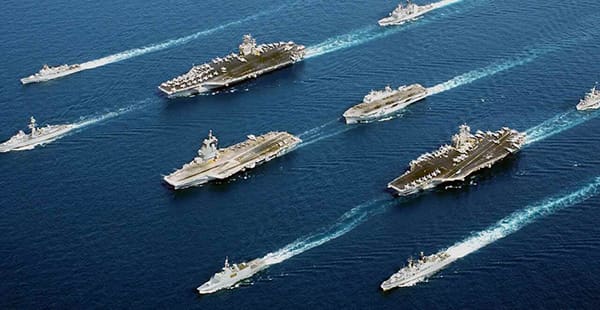How Was Asbestos Used on Ships?
Commercial ships and naval vessels both need to withstand fire and extreme heat. As a result, asbestos was incorporated into ship and shipbuilding products to make them durable and fire resistant. The mineral was especially common in insulation used in boiler rooms, but ships also contained many other asbestos products like cement and adhesives.
Although many products on ships contained asbestos, the mineral was most heavily used in the boiler and engine rooms and for insulation purposes.
For instance, boilers produce high temperatures and steam. To contain the heat, asbestos insulation was often used to line the interior of the equipment. Most boiler insulation on ships contained about 15% asbestos. Other asbestos components, such as gaskets, were often used in boilers to further improve fireproofing and durability.
Pipes on ships may also contain large amounts of asbestos insulation. Research suggests pipes were often insulated with a layer of felt containing up to 50% asbestos fibers.
Any repairs or maintenance on asbestos materials could cause dangerous fibers to become airborne. Because ships had tight quarters and poor ventilation, this could put anyone on board at risk of asbestos exposure.
Asbestos Use on Ships Today
Today, asbestos on ships is less of a hazard than it once was. Although asbestos is still not fully banned, commercial and military ships stopped using it beginning in the late 1970s. But older ships may still contain asbestos products.
If the asbestos materials remain in good condition and are not disturbed, they are generally not an immediate danger to human health. However, any disturbed asbestos materials may pose an exposure risk for anyone on the ships.
Navy Ships Built With Asbestos
Many types of ships used asbestos, ranging from aircraft carriers to submarines. As a result, hundreds of ships used commercially and by the military contained the mineral. For most of the 20th century, Navy ships contained many products made by asbestos companies. This put thousands of crew members, shipyard workers, veterans and passengers at risk of exposure.
Aircraft Carriers
Aircraft carriers are warships used to transport aircraft. Aircraft carriers were first built in 1922 and became more prominent during times of war. These Navy vessels were in World War II, the Vietnam War, the Korean War and the Cold War. During these wars, asbestos was a popular component in shipbuilding, putting those who served on or maintained aircraft carriers at risk of exposure. Examples of prominent aircraft carriers active during the period of heavy asbestos use in the Navy include:
- USS Constellation (CVA-64 / CV-64)
- USS Independence (CV-62)
- USS Kitty Hawk (CVA-63 / CV-63)
- USS Lexington (CV-16)
Amphibious Warships
Amphibious warships are designed to land ground force cargo and support U.S. Marines on land. The Navy largely commissioned these ships during the 1940s, when asbestos use was prominent. Amphibious warships, such as the USS Cavalier, were built with many asbestos products. This posed a health risk to crew members and veterans. Examples of prominent amphibious warships active during the period of heavy asbestos use in the Navy include:
- USS Cavalier (APA-37)
- USS Elmore (APA-42)
- USS Queens (APA-103)
- USS Terrell County (LST-1157)
Auxiliary Vessels
Auxiliary vessels play an important role in the U.S. Navy. These ships support combat vessels on missions by supplying fuel, ammunition, supplies and more. They have been a critical part of the Navy for more than 100 years. Auxiliary ships used asbestos just like many other Navy ships. Asbestos was used during ship construction and in various components, which put sailors at risk of exposure. Examples of prominent auxiliary vessels active during the period of heavy asbestos use in the Navy include:
- USS Caloosahatchee (AO-98)
- USS Grand Canyon (AD-28)
- USS Guadalupe I (AO-32)
- USS Manatee (AO-58)
- USS Mauna Kea (AE-22)
- USS Piedmont (AD-17)
- USS Shasta (AE-6)
- USS Wrangell (AE-12)
- USS Zelima (AF-49)
Battleships
Navy battleships were versatile during wartime. Construction of the popular ships started in the early 1900s. As a result, many battleships were built with asbestos-containing products to protect them from extreme heat and fire. Battleships could carry several thousand passengers at a time, putting crew members, soldiers and others at risk of asbestos exposure. Examples of prominent battleships active during the period of heavy asbestos use in the Navy include:
- USS Arizona (BB-39)
- USS Missouri (BB-63)
- USS New Jersey (BB-62)
- USS Texas (BB-35)
Cruisers
Cruisers are large combat ships that served during World War I, World War II, the Korean War, the Vietnam War and the Cold War. More than 140 Navy cruisers were constructed and repaired with asbestos-containing products. Navy personnel aboard cruisers were at great risk of asbestos exposure, especially those serving in the engine and boiler rooms. Examples of prominent cruisers active during the period of heavy asbestos use in the Navy include:
- USS Baltimore (CA-68)
- USS Bremerton (CA-130)
- USS San Francisco (CA-38)
- USS Worden (CG-18)
Destroyers
Navy destroyers are fast warships first commissioned in the early 1900s. Destroyers were built and repaired using asbestos in boilers, pumps and other equipment. With more than 300 active destroyers during World War II alone, thousands of veterans potentially faced exposure aboard these ships. Examples of prominent destroyers active during the period of heavy asbestos use in the Navy include:
- USS Benner (DD-807)
- USS Chevalier (DD-805)
- USS Dixie II (AD-14)
- USS Maury (DD-401)
- USS O’Bannon (DD-450)
- USS Prichett (DD-561)
Destroyer Escorts
Destroyer escorts were primarily used to support the Merchant Marines during World War II. The United States built more than 450 destroyer escorts to support these efforts. Many of these ships contained asbestos products. As a result, thousands of people faced exposure and the risk of developing mesothelioma. Examples of prominent destroyer escorts active during the period of heavy asbestos use in the Navy include:
- USS Slater (DE-766)
- USS Stewart (DE-238)
Escort Carriers
Escort carriers were predominantly used during World War II. More than 120 escort carriers were built during this time, all of which may have used asbestos materials. Sailors who served on or maintained these ships risked asbestos exposure. Examples of prominent escort carriers active during the period of heavy asbestos use in the Navy include:
- USS Block Island (CVE-21)
- USS Thetis Bay (CVE-90)
Frigates
Frigates were another active ship type during World War II. Frigates primarily escorted and protected destroyers. At least 114 frigates were active during World War II. All of these ships may have been built and repaired with asbestos products. Examples of prominent frigates active during the period of heavy asbestos use in the Navy include:
- USS Bronstein (FF-1037)
- USS Garcia (FF-1040)
- USS Glover (FF-1098)
- USS McCloy (FF-1038)
Merchant Marine Ships
The Merchant Marines serve as an auxiliary branch of the military. At one point, there were more than 1,000 Merchant Marine ships in its fleet. Asbestos was frequently used in the ships’ construction. Although many of these ships are no longer active, Merchant Mariners are still at risk of mesothelioma cancer from past exposure. Examples of prominent Merchant Marine ships active during the period of heavy asbestos use in the military include:
- SS Bay State
- SS Copper State
- SS Pan Massachusetts
- SS Samuel Chase
Minesweepers
Minesweepers were responsible for clearing an open area of mines so larger naval warships could pass through safely. During World War II alone, shipbuilders constructed more than 350 minesweepers. Those who served aboard these ships may have been exposed to asbestos. Examples of prominent minesweepers active during the period of heavy asbestos use in the Navy include:
- USS Aggressive (MSO-422)
- USS Illusive (MSO-448)
- USS Lapwing (AM-1)
- USS Phoebe (MSC-199)
Rescue and Salvage Ships
Rescue and salvage ships serve a number of purposes relating to helping stricken vessels. Operations carried out by these ships include salvaging, towing, offshore firefighting and heavy lifting. Examples of prominent rescue and salvage ships active during the period of heavy asbestos use in the Navy include:
- USS Grasp I (ARS-24)
- USS Opportune (ARS-41)
Submarines
Submarines served in many wartime efforts. During World War II, there were at least 280 submarines in active service. Those who worked or served on submarines spent much of their time in confined areas with poor ventilation. As a result, they may have been frequently exposed to high levels of harmful asbestos, leaving many at risk of developing mesothelioma. Examples of prominent submarines active during the period of heavy asbestos use in the Navy include:
- USS Aspro (SS-309)
- USS Pomodon (SS-486)
- USS Rock (SS-274)
- USS Tinosa (SSN-606)
Who Is at Risk of Asbestos Exposure on Ships?
Crew members, Navy personnel, shipyard workers and passengers were at risk of asbestos exposure on ships. Some people who worked in poorly ventilated spaces, like boiler workers, faced especially high risks of exposure. Navy veterans and shipyard workers are among the most at risk for exposure and developing a disease such as mesothelioma.
Family members of these workers and military service members were also at risk of secondary exposure. Workers could unknowingly bring home asbestos fibers on their person.
No amount of asbestos exposure is considered safe. Veterans and others who worked on ships containing asbestos materials may be at risk of diseases such as mesothelioma, asbestosis and asbestos lung cancer. It can take decades after exposure for these illnesses to present symptoms.
Individuals who believe they may have been exposed to asbestos on a ship should talk to their doctors.
Occupational Exposure in Ship-Related Industries
Asbestos use occurred in more places beyond commercial and Naval vessels. Workers at the following ship-related locations also faced exposure risks:
- Docks
- Naval hospitals
- Shipbreaking facilities
- Ship construction centers
- Shipyards
- Supply depots
Navy veterans and laborers at these locations may have come into contact with asbestos.
Asbestos Lawsuits and Compensation
Veterans and others who develop mesothelioma from asbestos exposure on ships have compensation options. Many veterans have sought payouts from companies that provided asbestos materials to the U.S. Navy. As a result of successful lawsuits, these companies have been found liable for millions of dollars.
Veterans and laborers with mesothelioma may be able to file personal injury lawsuits. Families of people who have passed from mesothelioma may also have legal options. Wrongful death lawsuits can help families get compensation and seek justice against asbestos companies.
Mesothelioma law firms specialize in representing asbestos exposure victims. Lawyers at these firms have won numerous settlements and verdicts for their clients.
Navy or Marine Corps veterans who served on asbestos-containing naval ships may be eligible for various veterans benefits. Through the U.S. Department of Veterans Affairs (VA), veterans who develop an asbestos-related disease may be eligible for low-cost treatment at VA health centers. Veterans may also be eligible for VA benefits.
Some people may also be eligible to file asbestos trust fund claims. Various asbestos manufacturers have gone through bankruptcy proceedings and created trust funds to compensate victims.
An experienced lawyer can help asbestos victims understand all of their filing options.
Reducing Asbestos Exposure Risks on Ships
Although asbestos use was no longer common after the 1980s, past uses may still pose a health risk. The Occupational Safety and Health Administration (OSHA) developed a program and regulations to help prevent exposure on ships. The U.S. Navy also created a program to help those with previous exposure.
OSHA maintains the National Emphasis Program on Shipbreaking to reduce workplace hazards at shipyards. As part of the program, ships and shipyards must undergo safety and health inspections. These inspections may identify hazards, such as asbestos, and help eliminate exposure risks. In addition to this program, the agency has other regulations in place for asbestos handling at shipyards to protect workers.
The Navy also developed a program to help monitor veterans’ health, called the Asbestos Medical Surveillance Program (AMSP). The AMSP maintains records for those who have faced occupational exposure. Doctors monitor their health through various exams such as lung tests.
These programs and other federal asbestos regulations can help those who already experienced exposure and potentially prevent future asbestos exposure on ships.
Common Questions About Asbestos Exposure on Ships
- When was asbestos banned on ships?
In the 1970s, the Navy implemented policies to remove and replace asbestos insulation. The Navy seems to have eliminated most asbestos use around 1985. Commercial ships likely stopped using asbestos in the 1980s, when regulations and public pressure caused most companies to stop using the mineral.
- Can you sue the Navy for asbestos exposure on ships?
It may be possible to sue the Navy for exposure. But most mesothelioma lawsuits are against companies that supplied asbestos products to the Navy. A mesothelioma lawyer can explain the best legal strategy for your individual case.
- Is asbestos still on ships?
Shipbuilders no longer use asbestos to build ships. Substitute materials are used to insulate and fireproof materials and machines. But asbestos may still be present on older ships. If older materials become damaged, they can release asbestos fibers into the air.
- Do countries outside the United States still make ships with asbestos?
In the 2000s, estimates showed up to 80% of new ships worldwide contained asbestos. The United States has begun removing and substituting asbestos on commercial and military ships. But some parts used on them are made outside the United States and may still contain asbestos.







